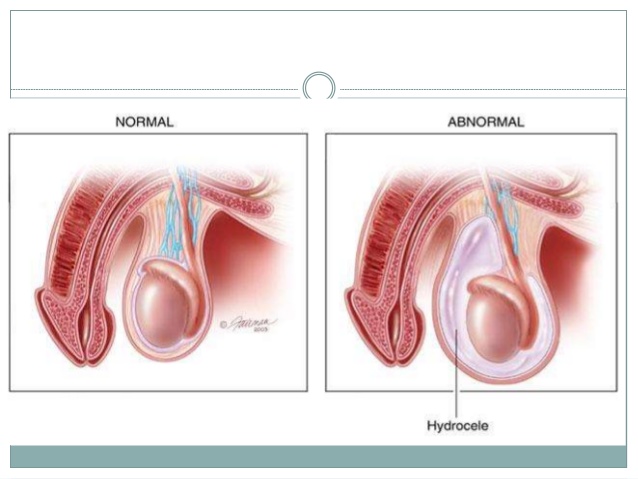HYDROCELE

Definition: A hydrocele is a fluid-filled sac surrounding a testicle that results in swelling of the scrotum, the loose bag of skin underneath the penis. [1]
Symptoms
Usually the only indication of a hydrocele is a painless swelling of one or both testicles. [2] Usually adult men will experience heaviness due to a swollen scrotum. A hydrocele is the most common cause of scrotal swelling and has been estimated to occur in as many as 1 percent of the adult male population. [2]
Men with a hydrocele are frequently asymptomatic, but may notice a scrotal mass. Usually this will occur due to scrotal or perineal trauma or an inflammatory cause (usually associated with frequency, urgency, dysuria, and painful scrotal swelling). Pain is often aggravated by standing and should be relieved when the testicle is elevated (Prehn’s sign). [2] Usually the mass feels smooth and the surrounding testicle is pain-free. In contrast, a cystic, non-tender mass arising from the head of the epididymis and distinct from the testicle is characteristic of a spermatocele. [2]
Causes
Normally in baby boys the testicles descend from the developing baby’s abdominal cavity into the scrotum and a sac (processus vaginalis) accompanies each testicle.[2] This sac allows fluid to surround the testicles. If the fluid remains after the sac closes, the condition is known as a noncommunicating hydrocele [2] and fluid can not flow back into the abdomen. Usually the fluid gets absorbed within a year and the hydrocele disappears but if the sac remains open the condition is known as a communicating hydrocele. [1]
Treatment
In many cases hydroceles often go away without treatment and require treatment only if it gets large enough to cause discomfort or the patient finds it socially unacceptable. One option is to remove the fluid in the scrotum with a needle (aspiration) but surgery is generally preferred. Aspiration may be the best alternative for people who have high surgical risks. [3]
Surgical excision (hydrocelectomy). Removal of a hydrocele is an outpatient procedure using general anesthesia or epidural. The surgeon may make an incision in the scrotum or lower abdomen to remove the hydrocele. [1]
A hydrocelectomy may require you to have a drainage tube and wear a bulky dressing over the site of the incision for a few days after surgery. Scrotal support after surgery and ice packs applied to the area intermittently during the first 24 hours after surgery may help reduce swelling. Surgical risks include blood clots, infection or injury to the scrotum. [2]
Needle aspiration. This treatment isn’t widely used because it is common for the fluid to return. It is possible to use an injection of a thickening or hardening (sclerosing) drug after the aspiration to prevent the fluid from reaccumulating. Risks of this procedure include infection and scrotal pain. [2]
When to see a doctor
See your doctor if you experience scrotal swelling, because it is important to rule out other possible causes for the swelling, such as torsion or a tumor. Sometimes a hydrocele is associated with an inguinal hernia, in which a weak point in the abdominal wall allows a loop of intestine to extend into the scrotum and which may require treatment. [1]
References
- Hydrocele. The Mayo Clinic. http://www.mayoclinic.com/health/hydrocele/DS00617/DSECTION=treatments-and-drugs
- Hydorcele. http://www.nlm.nih.gov/medlineplus/ency/article/000518.htm


